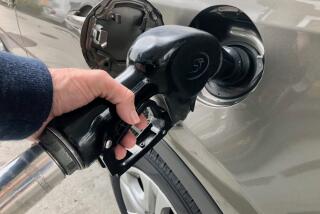MPG Ratings Flaws Hit Home at the Pump
- Share via
Millions of motorists who bought sport-utility vehicles and other passenger trucks in recent years are getting an unwelcome jolt of reality as the price of gasoline has soared in recent weeks.
The average price of a gallon of regular unleaded gas in California was $1.77 on Monday, the day the Energy Department conducted its regular weekly survey. At that price, filling up the 44-gallon tank on the Ford Excursion costs $77.88--for just enough fuel to get the giant SUV to San Francisco from Southern California.
These heavy, high-powered vehicles typically get less than 20 miles per gallon, based on the Environmental Protection Agency fuel economy rating on their window stickers. And the official mileage ratings are often flaky, bearing no relationship to what motorists can expect to get on the highway.
Although pickup and SUV drivers are among the hardest hit when official mileage estimates don’t meet reality, they aren’t the only ones who wonder about those mpg figures.
As gas prices creep upward, fuel economy is again an important consideration in choosing a vehicle. And it’s helpful to review the system used to produce the numbers.
The mileage estimates, printed by law on the manufacturer’s suggested retail price stickers on the windows of new vehicles, are supposed to be the official government-approved estimates, based on rigorous methodology consumers can depend on.
In fact, the estimates are not based on actual tests of vehicles on public roads. They are not based on tests conducted on test tracks. They are not even based on the direct results of runs on a laboratory dynometer, a rolling test track that allows a vehicle to remain stationary while its wheels turn.
Rather, the fuel economy estimates are based on a mathematical model that computes mileage from the vehicles tailpipe emissions of carbon while it runs on a dynometer, according to officials at the EPA.
Actually, the auto makers run the tests, with the EPA conducting periodic samplings to verify accuracy.
“Half the time, people don’t get that mileage,” said Robert F. Brennan, a Glendale attorney.
What does some local litigator know about this matter? Well, last year Brennan, representing Cynthia Rios, negotiated a settlement with Ford Motor Co. involving mileage claims for Rios’ Ford Expedition.
According to the SUV’s window sticker, it was supposed to get between 11 and 15 miles per gallon in city driving and 15 to 21 mpg on the highway.
But when Rios checked her actual mileage, something seemed terribly wrong. She was getting only 8.5 mpg, she alleged in a suit brought against Ford under California’s “lemon law” in Los Angeles Superior Court.
At 8.5 miles to the gallon, the 35-gallon tank on Rios’ Expedition was good for about 300 miles, barely enough to reach Las Vegas without a mid-desert refueling stop.
This is the kind of case almost any Expedition owner could file, Brennan said. In fact, he has handled other similar cases and says major auto makers rush to settle them because they “don’t want to see the inside of a courtroom with these claims.”
Details of Rios’ settlement were not disclosed.
A Ford spokeswoman said the company settled Rios’ claim for the sake of customer satisfaction and noted that it was based on Rios’ claims of problems with the transmission and front-end alignment rather than the claim about fuel efficiency. Ford said Rios had not complained about the fuel efficiency until after she filed suit. Ford also noted that its mileage ratings are in full compliance with EPA procedures that are widely used by the auto industry.
Don Zinger, assistant director of EPA’s Office of Transportation and Air Quality, strongly defends the agency’s test methodology as a valid tool for consumers to compare the fuel economy of various models, even if they will not necessarily get the mileage indicated on the window sticker.
“It is a very accurate measure of fuel economy,” Zinger said. “You could measure the amount of liquid fuel burned, but that would be much less accurate than the measurement of carbon consumed.”
The agency’s test for city driving is supposed to simulate a 7.5-mile stop-and-go trip with 18 stops and an average speed of 20 miles per hour.
The actual gas mileage a motorist gets is supposed to depend on driving conditions, the load being carried by the vehicle and the driver’s own habits behind the wheel, Zinger said.
Because the lab tests tend to inflate the mileage motorists might expect to get in real-world driving, the agency applies a fudge factor, lowering the city estimates by 10% and the highway estimates by 22% from the tests.
“Experience has proven that these adjustments make the mileage estimates in this guide correspond more closely to actual fuel economy realized by the average driver,” according to EPA documents.
Surprisingly, one thing that the EPA’s tests do not account for is wind resistance. And an SUV’s size can make it less aerodynamic than a smaller vehicle, Zinger acknowledges.
Here’s another idea: Maybe EPA chief Carol Browner and some of her top officials at the agency could personally test some of these vehicles on the streets of Washington to make sure that the agency is not giving American consumers bum advice.
Ralph Vartabedian cannot answer mail personally but responds in this column to automotive questions of general interest. Please do not telephone. Write to Your Wheels, Business Section, Los Angeles Times, Times Mirror Square, Los Angeles, CA 90053. E-mail: ralph.vartabedian@latimes.com.







